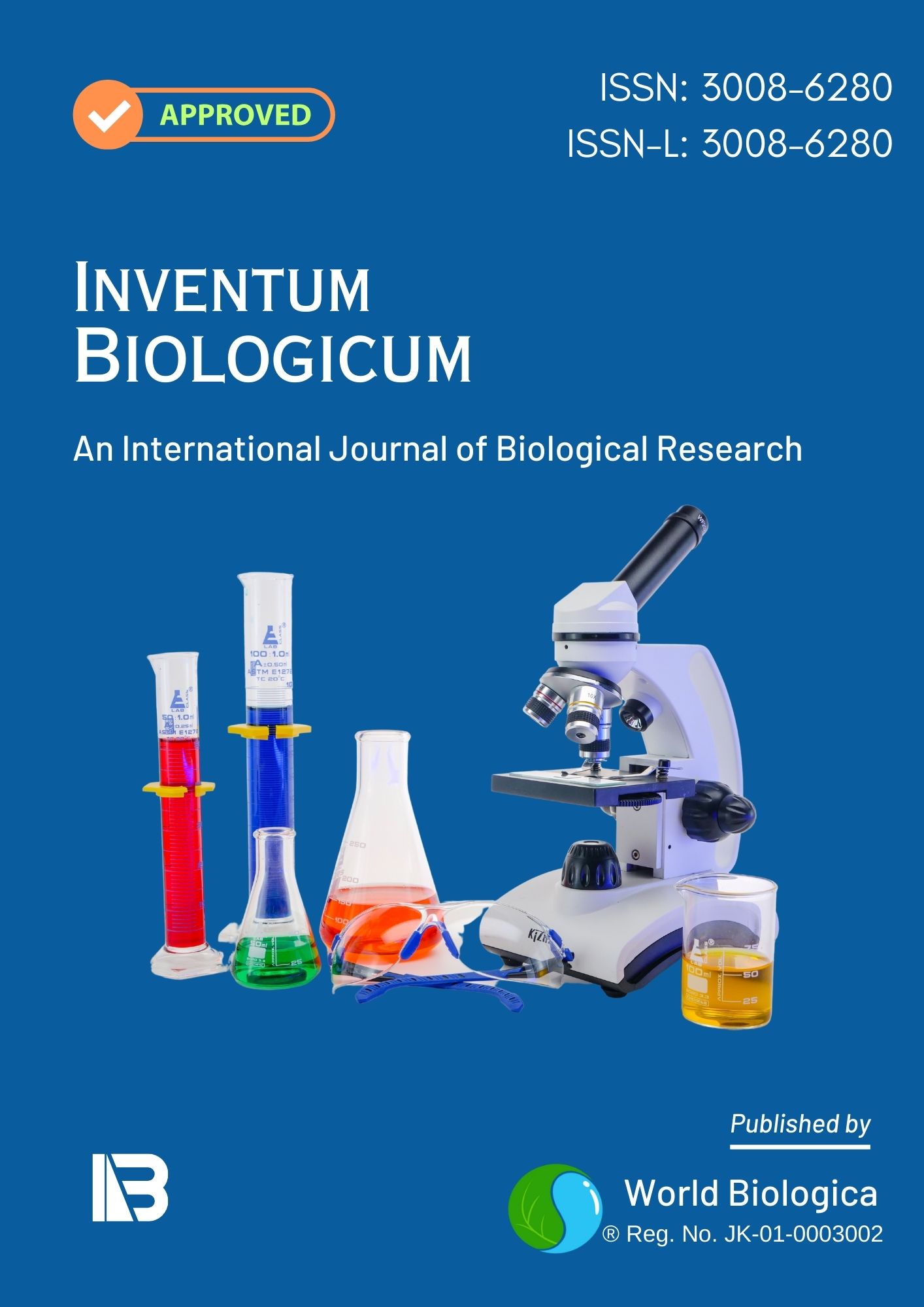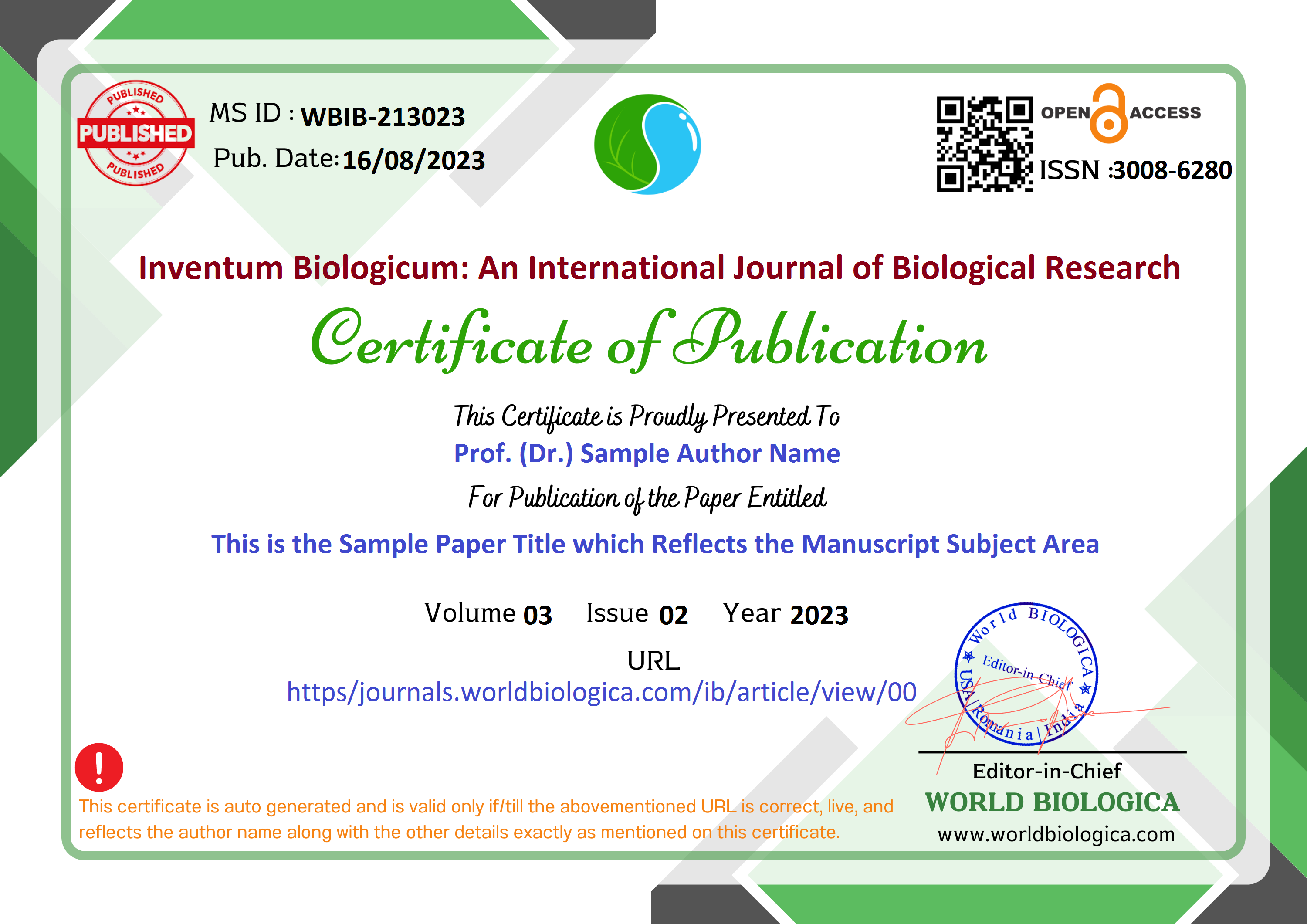Influence of Sodium Fluoride on Nitrate Reductase Inhibition and Physiological Changes in Plants
Keywords:
Sodium fluoride, Phytotoxicity, Nitrate reductase, Chlorosis, Necrosis, Fluoride accumulationAbstract
Sodium fluoride (NaF) poses significant phytotoxic effects on plants, primarily through the inhibition of key metabolic processes. Fluoride is readily absorbed by plant leaves and roots, accumulating in metabolically active cells, particularly at leaf tips and margins. This accumulation leads to a spectrum of symptoms depending on species sensitivity and environmental factors. Fluoride concentrations vary across species, with resistant plants such as cotton and asparagus tolerating higher levels without visible injury, while sensitive species like Chenopodium murale exhibit severe toxicity even at low concentrations.
Fluoride exposure induces structural and functional changes in plant cells, resulting in chlorosis, necrosis, and ultimately reduced photosynthesis, growth, and yield. Severe fluoride toxicity can lead to plant death, with affected leaves containing significantly higher fluoride levels than healthy ones. Sodium fluoride inhibits nitrate reductase (NR) activity in vivo, a critical enzyme for nitrogen metabolism, while not affecting its activity in vitro. Additionally, fluoride disrupts various physiological processes, leading to stunted growth, diminished photosynthetic pigments, and impaired antioxidative enzyme activity. It also interferes with cell signalling and calcium dynamics, crucial for fertilization and overall plant development. The cumulative impact of sodium fluoride on seed germination and seedling growth underscores the need for further investigation into its ecological consequences and management strategies to mitigate its effects on agricultural productivity and plant health.
Downloads
References
Ali, Q., Zain, A., & Awan, F. M. (2023). "Fluoride-induced oxidative stress in plants: Mechanisms and mitigation strategies." Environmental Science and Pollution Research, 30(2), 1532-1548.
Bhargava, A., & Bhardwaj, R. (2010). Fluoride toxicity in plants: A review. Environmental Toxicology and Pharmacology, 29(3), 1-11. https://doi.org/10.1016/j.etap.2010.05.002
Chauhan, S., & Agarwal, S. (2015). Fluoride toxicity in plants: Role of antioxidants in detoxification. Ecotoxicology and Environmental Safety, 112, 252-256. https://doi.org/10.1016/j. ecoenv.2014.10.028
Choudhary, S., Dutta, M., & Gupta, R. (2020). "Fluoride toxicity affects lipid metabolism and membrane integrity in plants." Plant Molecular Biology, 104(4), 397-412.
Das, A., Sinha, S., & Maity, S. (2015). Fluoride-induced physiological and biochemical changes in plants: An overview. Environmental Science and Pollution Research, 22(5), 3720-3735. https://doi.org/10.1007/s11356-014-3951-2
Das, S., Samanta, S., & Saha, R. (2015). Fluoride toxicity in plants: a review. Journal of Environmental Biology, 36(1), 29-37.
Datta, D., Saha, P., & Mukherjee, P. (2012). Effects of fluoride on chlorophyll and protein content in plants. Plant Archives, 12(2), 667-672.
Datta, S. K., Mandal, S. K., & Dutta, S. K. (2012). Physiological effects of fluoride toxicity on crops: A review. Indian Journal of Science and Technology, 5(1), 1-6. https://doi.org/10.17485/ijst/2012/v5i1/19836
Dey, S., & Dwivedi, S. K. (2014). Impact of fluoride on growth, chlorophyll and nutrient contents of Gram seedlings. Fluoride, 47(3), 232-237.
Divan, A., Shetty, A., & Nair, R. (2008). Effects of fluoride on seed germination and seedling growth in maize. International Journal of Plant Sciences, 3(2), 255-262.
European Food Safety Authority. (2008). Scientific opinion on the safety of sodium fluoride. EFSA Journal, 6(9), 748. https://doi.org/10.2903/j.efsa.2008.748
Gadi, B. R., Lal, B., & Chandran, S. (2012). Fluoride contamination in soil and groundwater: Overview of sources, mechanisms, and remediation. International Journal of Environmental Research, 6(2), 429-442.
Gadi, R., Singh, S., & Sharma, R. (2012). Fluoride toxicity in plants: An overview. Current Science, 102(2), 290-295.
García, E. J., León, F. A., & Parra, M. (2014). Phytotoxicity of sodium fluoride: Effects on germination and early growth of mustard seeds. Environmental Science and Pollution Research, 21(4), 2618-2627. https://doi.org/10.1007/s11356-013-2267-2
Gautam, N., & Bhardwaj, R. (2010). Physiological effects of fluoride on plants: A review. Journal of Environmental Biology, 31(5), 821-826.
Gautam, S., & Bhardwaj, P. (2010). Impact of fluoride toxicity on seed germination and seedling growth in Triticum aestivum and Zea mays L. Research Journal of Environmental Toxicology, 4(4), 210-217. https://doi.org/10.3923/rjet.2010.210.217
Gupta, A., Chaudhary, D., & Singh, M. (2009). Effect of fluoride on some physiological parameters of plants. Journal of Environmental Biology, 30(1), 115-118.
Gupta, S., Sharma, S., & Singh, R. (2009). Fluoride and its impact on plant growth and physiology: A review. Environmental Science and Pollution Research, 16(5), 455-468. https://doi.org/10.1007/s11356-009-0185-9
Higgins, C. P., et al. (2014). Environmental impacts of fluoride. Environmental Science & Technology, 48(3), 1952-1961. https://doi.org/10.1021/es4044375
Higgins, J. T., Thomas, C. L., & Lambers, H. (2014). The role of fluoride in plant health: Ecological and physiological perspectives. Environmental Toxicology and Chemistry, 33(7), 1535-1542. https://doi.org/10.1002/etc.2601
Huang, C., Zhang, Y., & Xu, H. (2016). Fluoride pollution from phosphate fertilizer production in China and the role of soil pH. Environmental Geochemistry and Health, 38(5), 1221-1232. https://doi.org/10.1007/s10653-015-9762-6
Huang, X., Li, H., & Li, S. (2016). Fluoride pollution from phosphate fertilizers: Sources, impacts, and solutions. Journal of Soil and Sediment, 16(4), 1044-1057. https://doi.org/10.1007/s11368-016-1368-y
Jha, A. S., Bhardwaj, A. K., & Gupta, K. (2013). The role of fluoride in plant physiology: A review. Fluoride, 46(1), 1-10.
Jha, P., & Dubey, R. S. (2015). Effects of fluoride on chlorophyll and protein contents in germinating mung bean seedlings. Environmental Monitoring and Assessment, 187(10), 645. https://doi.org/10.1007/s10661-015-4820-4
Jha, S. K., Nayak, A. K., & Sharma, Y. K. (2013). Fluoride toxicity in plants and its remediation by phytoremediation technology: A state-of-the-art review. Environmental Science and Pollution Research, 20(7), 4537-4555. https://doi.org/10.1007/s11356-013-1673-7
Khan, N. A., Khedher, A., & Anis, M. (2021). "Influence of sodium fluoride on protein metabolism and amino acid composition in plant tissues." Plant Physiology and Biochemistry, 165, 101-109.
Kumar, P., Sharma, S., & Pandey, A. (2014). Effect of fluoride on antioxidative enzymes in plants. Journal of Plant Sciences, 2(6), 265-271. https://doi.org/10.11648/j.jps.20140206.15
Kumari, M., & Singh, S. (2019). Fluoride toxicity in agriculture: Implications for sustainable crop production. Fluoride, 52(3), 391-401.
Li, P., Wang, Y., & Li, Z. (2018). Fluoride in agricultural soils and crops: Potential risk and its environmental relevance. Environmental Pollution, 239, 227-237. https://doi.org/10.1016/j.envpol. 2018.04.028
Li, W., et al. (2018). Impacts of fluoride pollution from coal-fired power plants on soil and crops. Science of the Total Environment, 634, 347-354. https://doi.org/10.1016/j.scitotenv.2018.04.166
Patra, S., Mukherjee, S., & Ghosh, S. (2018). Fluoride-induced oxidative stress and its impact on photosynthetic pigments in green plants. Journal of Plant Physiology and Biochemistry, 125, 12-18. https://doi.org/10.1016/j.jplph.2018.01.005
Reddy, P., & Aery, N. C. (2013). Effect of fluoride on photosynthetic pigments in Triticum aestivum L. Environmental and Experimental Botany, 88, 78-82. https://doi.org/10.1016/j.envexpbot. 2013.11.007
Rout, G. R., Sahoo, S., & Das, P. (2016). Fluoride toxicity in plants: Responses, mechanisms, and tolerance. Environmental Toxicology and Pharmacology, 45, 47-60. https://doi.org/10.1016/j. etap.2016.06.014
Sabal, I. M., Akhtar, K., & Sultana, A. (2006). Effects of sodium fluoride on growth and biochemistry of green gram (Vigna radiata L.). Pakistani Journal of Biological Sciences, 9(4), 631-635.
Sabal, S. M., Bhardwaj, P., & Singh, R. P. (2006). Physiological effects of fluoride on plants: A review. Journal of Plant Physiology, 163(3), 292–303. https://doi.org/10.1016/j.jplph.2005.02.013
Sant’Anna-Santos, B. F., Azevedo, A. A., Aguiar, R., & Ferreira, R. S. (2013). Effects of fluoride on plant physiological traits: A review on molecular responses, tolerance mechanisms, and adaptation. Ecotoxicology and Environmental Safety, 89, 104-115. https://doi.org/10.1016/j.ecoenv.2012.11.012
Sharma, S., & Patni, S. (2017). Environmental implications of fluoride on plants and soil. Fluoride, 50(2), 165-172.
Sharma, S., Kumari, R., & Sharma, P. (2017). Fluoride toxicity in plants: A review of oxidative stress and defense responses. Ecotoxicology and Environmental Safety, 145, 85-93. https://doi.org/10.1016/j.ecoenv. 2017.07.038
Sharma, V., Kumari, S., & Khanna, S. (2022). "Impact of fluoride on mitochondrial functions in plants." Journal of Environmental Management, 301, 113809.
Singh, A. K., Kumar, Y., Kumar, P., Mishra, G., & Singh, C. (2019). Fluoride in the environment: Sources, impacts, and remediation strategies. Environmental Science and Pollution Research, 26(12), 11750–11762. https://doi.org/10.1007/s11356-019-04593-0
Singh, M., Kumar, A., & Kumari, R. (2019). Natural and anthropogenic sources of fluoride in the environment: The role of phosphate fertilizers and soil composition. Journal of Environmental Management, 231, 80-87. https://doi.org/10.1016/j.jenvman.2018.10.010
Srivastava, A., Singh, S., & Bhargava, M. (2015). Effects of fluoride on photosynthesis, growth, and nutrient uptake in plants: A review. Fluoride, 48(4), 293-302.
Wellburn, A. R. (1998). The spectral determination of chlorophyll a and b, as well as total carotenoids, using various solvents: The relationship between light absorbance and pigment concentration. Journal of Plant Physiology, 153(3), 263-268.
Yang, J., Wang, Y., & Xie, C. (2022). Agricultural resilience to fluoride contamination: Investigating the tolerance of various crops. Agricultural and Environmental Sciences, 72(3), 407-414. https://doi.org/10.1002/aes.312
Yang, Y., et al. (2022). The role of sodium fluoride in agriculture: Toxicological effects and implications for plant health. Agronomy, 12(4), 925. https://doi.org/10.3390/agronomy12040925
Zhang, H., et al. (2017). Sources and environmental effects of fluoride in agricultural areas. Environmental Pollution, 230, 145-152. https://doi.org/10.1016/j.envpol.2017.06.048
Downloads
-
Download PDF
 Abstract Views: 78,
Abstract Views: 78,  Download PDF: 75
Download PDF: 75
Published
How to Cite
Issue
Section
License
Copyright (c) 2024 Inventum Biologicum: An International Journal of Biological Research

This work is licensed under a Creative Commons Attribution-NonCommercial-NoDerivatives 4.0 International License.


















